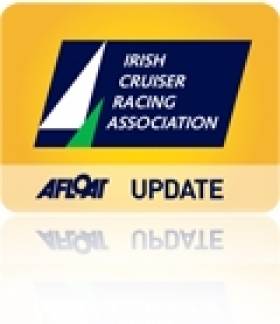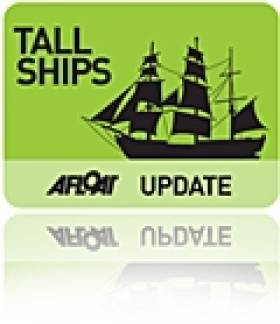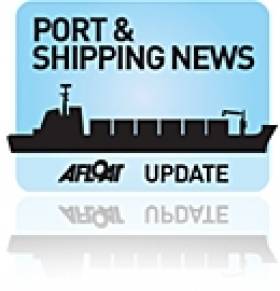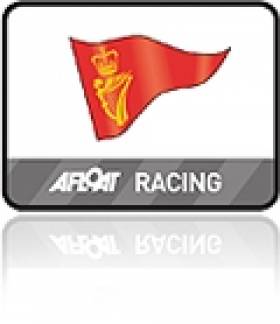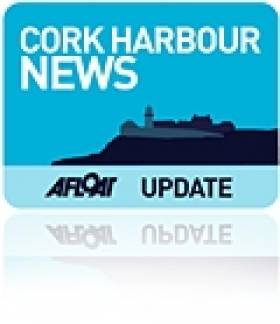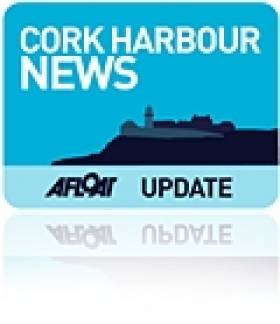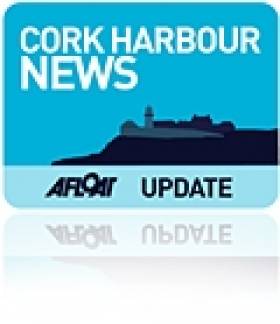Displaying items by tag: Cork Harbour
Windy Start Expected for Friday's ICRA Nationals
In Class 0 Local boats Antix, Anthony O'Leary; Jump Juice, Conor Phelan and Gloves off Kieran Twomey will be challenged By George Sisk's new Wow, Norbert Reilly's Crazy Horse and Richard Fides Welsh entry Impetuous which is a former Blondie.
Class 1 sees a fine Class where last years Echo winner Ian Nagle's Jelly Baby will be challenged by sister ship Peter Reddin's Jetstream Denis Hewitt and friends on Raptor and likes of Donal O Leary's D Tox.
Class 2 will see a battle between Corby 25s; Vinny O' Shea's Yanks and Franks, Brian Goggin's new Allure and Denis Coleman's Thunderbird.These will be tested by likes of Conor Rohan's Ruthless, Shane Statham's Slack Alice Kieran and Liz O Brien's Magnet and Desmond Ivers Deasy combo on Bad Company.
Class 3 has a backbone this year of state of the art Quarter Tonners. ICRA are welcoming Black Fun Jamie Mc Dowell all the way from New Zealand where he will be challenged by Neil Kenefick's Tiger, Eamon Rohan's Anchor Challenge who will be up against Leonard Donnery's No Knomes, John Twomey's Blazer 23 Shilelagh and Sullivan Brothers in Running Wild. Fergus Coughlan's White Knight from Cobh will also challenge.

New Zealand yacht Black Fun, complete with torpodeo keel, has arrived in Crosshaven for Friday's Cruiser National Championships. Photo: Bob Bateman
First time Class 4 will see Kevin O Connor's Gaelic Kiwi take on likes of Alan Carroll's Sundancer and Michael Sexton' Granny Knot.
The Non Spinnaker Corinthian Cup sees a fine fleet where Billy and Hilary Duane's Expression will compete against Clive Doherty's Phaeton Bill O Mahony's Julia B and Seamus Gilroy's Split Point.
John Downing's Samba and Conor O Donovan's Extension will also be in contention.
Day Prize Sponsors Dubarry have come up with the innovative idea that each crew on the winning boats in IRC and Echo each day will receive a prize in reward for their efforts.Two styles of Dubarry sailing hats and custom sailing socks will be included in this effort to recognise crews and offer variety each day.
The Royal Cork have laid on high standard racing on the water under Race Officers Peter Crowley and Richard Leonard and crews will be warmly welcomed ashore to a carnival type atmosphere with music and casual food on the go immediately after racing.
Mansfield Returns to 1720s With a Title Win
After a break of five years, former class European champion Mark Mansfield returned to the 1720 class at the weekend and won the CH Marine sponsored national championships in Cork Harbour from a fleet of 14 boats.
The last race of the eight race championship decided the winner between Anthony O'Leary and Mansfield. In a fleet packed with previous owners the fleet also had all three helms from the winning 2010 Commodores' cup team sailing. Andrew Creighton was steering Aquatack, Nicholas O'Leary was steering T bone and Anthony O'Leary steering his own boat.
Although the sailing in 8-12 knots went according to plan a number of support boats were damaged in an incident unrelated to the racing.
Mansfield and his crew of Terry English, Mike Budd, Dave Meagher and Joe Bruen won half of the eight races and discarded a fourth to take the national title. Second overall was Anthony O'Leary and third Nicholas O'Leary.
The class hope that more crews can be attracted in to the sportsboat and the resurgence of the class in Cork Harbour continues.
Brando’s ‘Bounty’ Bound for Bloomsday
The tallship used in the 1962 film of 'Mutiny and the Bounty' starring Hollywood screen legend Marlon Brando is to make a Bloomsday arrival to the rebel city, writes Jehan Ashmore.
H.M.S. Bounty is a replica of the ship in the famous 1789 mutiny against Captain William Bligh. The tallship is to dock at Albert Quay in Cork city-centre and will be made open to the public on Friday 17th, Saturday 18th and Sunday 19th June (daily between 11am – 6pm).
Tours on board the Bounty are self-guided with crew assistance and the admission charge is €10 for adults and children €5, children under four years go free.
In recent years the Bounty has appeared in 'Pirates of the Caribbean II' and in the Lone Wolf Production Group documentary on 'Blackbeard'. The ship also appeared in 2003 for a documentary on Captain Bligh for the History Channel, and the Sponge Bob Square Pants movie, which was released in November 2004. Also in that year the tallship was used in an episode for MTV.
For more information about the Cork visit click HERE and for the Bounty's voyages and background, visit www.tallshipbounty.org
US Training-Ship Heads for Cork
For five-days the US training-ship State of Maine will make Cork Harbour her port of call, when the 16,000 tonnes vessel docks this evening, writes Jehan Ashmore.
The 500-foot long ship is on a 55-day training cruise that started late last month from her homeport of Castine Harbour in Maine. Since then the Maine Maritime Academy's training-ship has visited Norfolk, Virginia before crossing the Atlantic to include calls to Valetta, Malta and the vessel's most recent port of call was Civitavecchia in Italy.
Onboard the former oceanographic vessel that served in the US Navy as the USNS Tanner, there are students, officers and crew. The Maine Maritime Academy purchased the vessel in 1997 and she was converted to accommodate the training needs of the college.
The academy was founded in 1941 and enrolls more than 900 students from 35 states and from several foreign countries. Students in the college are awarded A.S., B.S., and M.S. degrees in 15 fields of study.
State of Maine is to berth at the Cobh Cruise Terminal, the facility which normally caters for cruiseships is to be followed by another training-ship the 17,000 tonnes Empire State on 22 June.
Doyle's Endgame Produces Results in Royal Cork Wine Race
A ding dong sailing battle for line honours between an A35 design and an X362 made up for last night's poor turnout at Royal Cork's Short handed Wine Race sponsored by Karwig.
Frank Doyle's Endgame (A35) beat Derry Good's X362 Sport Exhale on IRC Handicap in a tightly raced affair over a Cork Harbour course.
With a blustery westerley and a biting wind for this time of year it was only the hardy took to the water. Those that did had a great night of racing and entertainment. With a start from the committee boat at the grassy competitors got off on a run heading for Corkbeg before rounding to beat back to No. 8.
As usual, this was a choice of going left or right with the flood tide and from Corkbeg a reach to No. 10 where your photographic scribe was waiting in eager anticipation of the colours that were going to spring at him. However, it was not to be and perhaps they made a wise choice.
From No. 9 they reached back to Corkbeg with a fetch to finish at the beautifully refurbished Adrielle with Rory Fitzpatrick doing the honours as Race Officer.
After an exhilirating race the prospect of the warm clubhouse awaiting the competitors was very enticing and paricularly so in view of the generous wine prizes which were presented to every competing boat.
Rear Admiral Ronan Enright presented the prizes and paid due tribute and thanks to the generous sponsorship of locally based Karwig Wine Suppliers.
Results below.
Royal Cork now turns its attention to the 1720 Sportsboat Nationals running this Thursday to Saturday. 15 boats are expected. On Sunday the Examiner newspaper sponsored Round Spike Island race is also being staged.
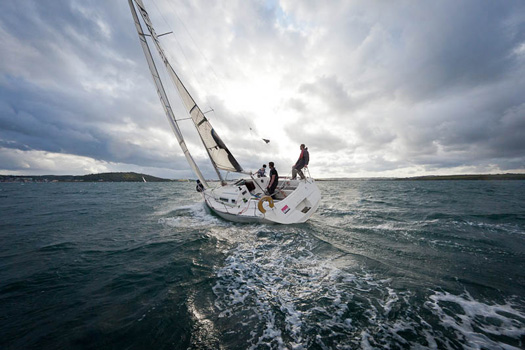
Action from last night's Shorthanded Wine Race. Photo: Bob Bateman. More photos below.
Shorthanded Wine Race:
Results IRC 1 Endgame 2, Magnet MG335 Kieran and Liz O'Brien 3, Wicket Sunfast 3 Mark Mendell.
Results Echo All In. 1 Silk Breeze Dehler 36 Ernie Dillon, 2 Exhale X362 Sport Derry Good, 3 Thistle Hustler 25.5 Peter Webster.
The conditions were ideal with a 7–knot breeze coming from the S.E. with flat water, blue skies and at the top of the tide. The harbour was looking its best.
The Race Officer set an excellent course. A bit of bias on the line made the start a bit interesting though. Class One got away clean. But Classes two and three had a General Recall.
After the start at Grassy the fleet had a beat out to No.3 The usual debate ensued over which side of the course was favoured. It was a close call in the end. Around No. 3 to starboard, spinnaker up and back to the Cage Bouy. A gybe and then on to No.12 at this stage there was a nice bit of ebb in the tide. It really was a case off keeping the Spinny flying for as long as possible up to the Mark. A nice beat followed, down to Corkbeg and then a nice reach back to the Grassy where the S flag was flying.
It was a good night for Billy Duane in his Sunlight 30 Expression in the White Sail fleet and for Jimmy Nyhan and Maritta Buwalda in their 1/4 Tonner Outrigger in Class 3.
First places also went to Thunderbird a Corby 25 owned by Denis Coleman in Class 2 and Endgame an A35 owned by Frank Doyle in Class 1.
GardaI Investigate U-boat Looting in Cork
Cork gardaí are investigating the looting of items from a First World War U-boat recently discovered off Roches Point.
The Irish Times reports that the submarine also appears to have been damaged by the illegal salvagers.
A spokesperson for the underwater archaeology unit of the Department of Arts, Heritage and the Gaeltacht confirmed that reports had come in from divers regarding disturbance of the wreck site - noting attempts to remove parts of the structure, and details of human remains.
Divers with the unit were expected to assess the site as soon as weather permits.
Items believed to have been taken include sailor's attire belonging to the crew of the 49-metre German vessel UC-42, which sank in 1917. The German embassy has indicated its "legitimate interest" in the preservation of the wreck.
The Irish Times has more on the story HERE.
Invitation to Cork Harbour Summer School
The first Cork Harbour Summer School, hosted by Meitheal Mara, takes place on Friday 10 June at the Custom House Offices of the Port of Cork.
The school, to be opened by Minister for the Marine Simon Coveney, will bring together speakers from the principal authorities with responsibility for the harbour and people with a vision for its future.
The summer school will encourage a better appreciation of Cork Harbour as a resource, with a focus on subjects from leisure in a working port to history and heritage, marine recreation, leisure tourism, and getting people afloat.
There will also be ample time for mingling and exchange of views informally between contributors and audience, which is an important part of the school.
The Cork Harbour Summer School is part of Ocean to City, Cork’s maritime festival with a programme of activities from Friday 3 to Sunday 12 June.
The event is free for individuals. RSVP no later than Friday 3 June.
More details about the Cork Harbour Summer School programme are available HERE.
New Website for Cork Harbour
A new website for Cork Harbour has been launched at CorkHarbour.ie providing up-to-dae information for local residents and anyone who uses the harbour.
The site features videos and photo galleries of habour life as well as links to groups and organisations based in the area, and intends to promote the wide range of things for locals and visitors alike to see and do both on and off the water.
The site also includes links to the harbour's new Twitter and Facebook pages to get the very latest news.
Cork Harbour spans a wide area that stretches from Roche's Point in the east, taking in the city of Cork, all the way to Fort Camden, near Crosshaven, in the west.
For more information visit CorkHarbour.ie.
Ocean to City, Cork Harbour's annual maritime festival, takes place this year from 3-12 June.
The yearly celebration of Cork’s maritime history and its unique harbour begins on Friday 3 June when members of the public can voyage through the city by kayak, enjoy the thrill of a sea safari trip around Cork Harbour or follow TG4’s Padraig Ó Duinnín as he presents a historical walking tour and talk on rowing in Cork.
The highlight of the festival, An Rás Mór, takes place on Saturday 4 June and will see boats of all sizes row 15 nautical miles from Crosshaven via Cork Harbour, Monkstown and Blackrock before finishing at the boardwalk in Lapps Quay in Cork.
Around 400 Irish and International rowers will compete in a diverse range of vessels including dragon boats, kayaks, currachs, Celtic long boats, Cornish pilot gigs and Irish coastal rowing boats.
Sunday 5 June will see a special 10km kayak race through the city centre. The Irish Naval Service flagship LE Orla will also offer free public tours, while Meitheal Mara will host a guided voyage around the island of Cork by a variety of small craft.
To mark the Cork Harbour School and Heritage Trails Weekend from from 9-11 June, a series of events highlighting the attractions of Cork Harbour, both water and land based, will take place.
Activities include a summer school on the theme of 'recreation in a working port', which will be held in the Port of Cork on Friday 10 June and opened by Minister for the Marine Simon Coveney.
For more details visit www.oceantocity.com.



























